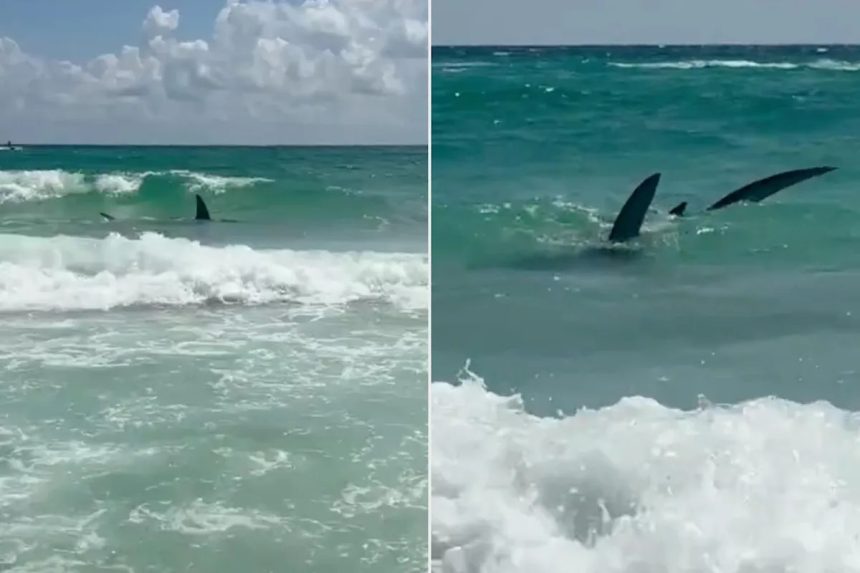NEED TO KNOW
-
A hammerhead shark and a stingray were filmed fighting just off the Florida coast on July 31
-
“It happened really fast, and next thing I know, my friends on shore are yelling for us to get out,” one bystander told PEOPLE
-
There have been 12 shark attacks in the U.S. this year, and the number has been declining since 2021
A shark and a stingray got into a dramatic fight off the Florida coast — and the brutal encounter ended with the shark taking a bite out of the stingray as horrified beachgoers watched on.
In footage shared to social media, the hammerhead shark and the stingray battle in the shallow waters near Florida’s Panama City on Thursday, July 31.
One video captured by beachgoers Annie Kremer and Connor Pelt and shared on TikTok shows the animals coming within feet of people standing in the sand, and the shark’s fins poking out above the water as the massive stingray juts into view.
“A few of my friends and I were in the water when it swam up,” Kremer told PEOPLE, detailing what happened in the viral video.
Annie Kremer and Connor Pelt
The fighting shark and stingray feet away from the shore.
“It happened really fast, and next thing I know, my friends on shore are yelling for us to get out,” she added. “We were probably five feet away.”
In the TikTok clip, one person standing on the shore calls out, “They’re eating each other!” as the animals continue to fight.
Eventually, the hammerhead emerges victorious, with the stingray washing ashore with a bite taken out of its pectoral fin.
Luckily, TODAY reported that there were no humans injured in the animal encounter, and Kremer shared that she felt lucky to experience a small glimpse of how the animals behave in their natural habitat.
“Once we ran to shore, it was really amazing to see a hammerhead shark like that up close,” she shared. “Just a reminder that we are in its home!”

Getty
A stock image of a hammerhead shark.
According to the. Florida Fish and Wildlife Conservation Commission, great hammerhead sharks are common sharks that inhabit the open ocean and the shallow coastal waters of both the Gulf and Atlantic coasts of Florida.
Stingrays are a staple in a Florida hammerhead’s diet, along with grouper, sea catfish, a variety of bony fishes, sharks, crabs, and squid, per the FWC. These sharks can also grow up to 18-19 feet long, although they mature at around eight to nine feet, and can live as long as 44 years.
https://people-app.onelink.me/HNIa/kz7l4cuf
More than a dozen species of stingrays are found in Florida’s waters, including the southern stingray, the yellow stingray, the Atlantic stingray, and several manta rays, per the FWC.
Although the type of stingray seen in this viral encounter has not yet been identified, species that are found in the same waters, such as the southern stingray, have a long, whip-like tail and are generally found in shallow areas, but are known to venture into deeper coastal waters up to 200 feet down.
Many stingray species have similar diets, often feeding on invertebrates, worms, small crustaceans, shrimp, crabs, mollusks, and even sometimes small fish.

Getty
A stingray is seen swimming off the coast of the Bahamas in this stock image.
Deadly shark attacks — as well as shark attacks in general — are considered exceedingly rare, and USA Today reports that they’ve been on the decline each year since 2021.
TrackingSharks, an independent website that collects data about shark attacks across the world, reports that there have been 12 reported shark attack bites in the U.S. this year, including 7 in Florida, 1 in Hawaii, 1 in North Carolina, 1 in New York, and 2 in South Carolina. None have been fatal.

Annie Kremer and Connor Pelt
The shark and stingray wrestle near the shore.
Never miss a story — sign up for PEOPLE’s free daily newsletter to stay up-to-date on the best of what PEOPLE has to offer, from celebrity news to compelling human interest stories.
To prevent any harmful encounters with animals, the FWC recommends that all beachgoers be aware of their surroundings, and people walking barefoot in shallow waters are urged to do the “stingray shuffle” — dragging their feet through the sand instead of taking big steps — to avoid getting a sharp sting on the bottom of their feet.
The FWC also states that most stingray injuries require immediate medical attention, and anyone who has been stung should call the National Poison Control Center at 1-800-222-1222.
Read the original article on People







